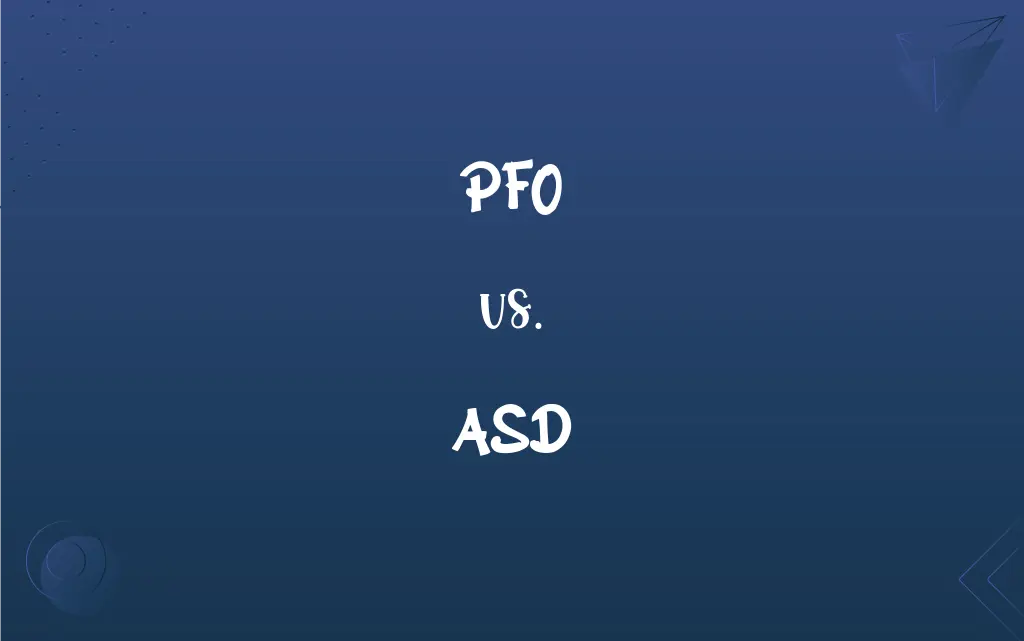PFO vs. ASD: What's the Difference?
Edited by Aimie Carlson || By Harlon Moss || Published on March 13, 2024
PFO (Patent Foramen Ovale) is a small opening in the heart that didn't close after birth, while ASD (Atrial Septal Defect) is a congenital heart defect forming a hole in the wall between heart's upper chambers.

Key Differences
PFO and ASD are both related to the heart but differ fundamentally in their nature and implications. A Patent Foramen Ovale (PFO) is a flap-like opening between the atrial chambers of the heart that fails to close naturally after birth, a process that occurs in about 25% of the general population. This condition is often asymptomatic and discovered incidentally. In contrast, an Atrial Septal Defect (ASD) is a congenital defect characterized by a hole in the atrial septum, allowing blood to flow between the heart's two upper chambers. This can lead to overcirculation in the lungs and heart failure if not treated.
PFO may not require any treatment unless it is associated with other complications such as stroke, ASD often necessitates medical intervention. Treatments for ASD might include medication, minimally invasive procedures to close the defect, or open-heart surgery, depending on the size and location of the hole and the patient's overall health. In contrast, a PFO might only be closed if it is directly linked to conditions such as cryptogenic stroke, and even then, closure is a subject of clinical debate.
The diagnosis of PFO and ASD involves different procedures, reflecting their distinct nature. For a PFO, an echocardiogram with a bubble study is often used to detect the passage of bubbles through the atrial septum when the patient performs a Valsalva maneuver. For ASD, more detailed imaging such as transthoracic or transesophageal echocardiography is required to visualize the defect's size and assess its hemodynamic impact.
Management strategies for PFO and ASD also diverge significantly. While observation and possibly aspirin therapy might be the only recommendations for someone with a PFO, an individual with ASD might undergo catheter-based closure or surgery. The decision is based on symptomatic relief and the prevention of long-term complications such as pulmonary hypertension.
The long-term outlook for individuals with PFO and ASD varies. Most people with a PFO lead normal lives without any need for treatment. However, ASD can have more serious implications if left untreated, including an increased risk of heart failure, atrial fibrillation, and stroke. Early detection and management are crucial for ASD to prevent these outcomes.
ADVERTISEMENT
Comparison Chart
Nature
A potential passage that remains open after birth
A congenital heart defect with a hole
Prevalence
Common, present in about 25% of the population
Less common than PFO
Symptoms
Often asymptomatic
Can cause symptoms like fatigue and shortness of breath
Treatment Necessity
Rarely requires intervention unless causing complications
Often requires intervention
Potential Complications
Stroke (in rare cases)
Heart failure, atrial fibrillation, stroke
ADVERTISEMENT
Diagnostic Tests
Echocardiogram with a bubble study
Echocardiogram, MRI, CT scan
Treatment Options
Observation, possibly closure for specific cases
Closure (catheter-based or surgical), medication
PFO and ASD Definitions
PFO
A condition requiring medical attention only if associated with other health issues.
Since my PFO is not causing problems, we're just monitoring it.
ASD
A congenital anomaly detectable through specific heart imaging tests.
The echocardiogram confirmed the presence of an ASD.
PFO
A passage between the heart's atrial chambers that usually closes after birth.
A routine checkup revealed I have a PFO, but I'm asymptomatic.
ASD
A risk factor for developing pulmonary hypertension if untreated.
To avoid pulmonary hypertension, the doctor recommended closing her ASD.
PFO
A heart condition often found incidentally during other medical evaluations.
My doctor discovered my PFO during an echocardiogram for something else.
ASD
A hole in the heart's atrial septum present from birth.
My child was diagnosed with an ASD and may need surgery.
PFO
A cardiac anomaly that may contribute to cryptogenic stroke in some patients.
After my stroke, they closed my PFO to prevent another.
ASD
A cardiac defect that can lead to overcirculation of blood in the lungs.
Because of her ASD, she gets tired more quickly than other kids her age.
PFO
A potential risk factor for certain types of heart-related complications.
My PFO puts me at a slightly higher risk for stroke, so I'm on aspirin.
ASD
A condition often requiring intervention to prevent serious complications.
He had his ASD closed through a catheter-based procedure.
FAQs
What is ASD?
An Atrial Septal Defect is a congenital heart defect featuring a hole in the wall between the heart's upper chambers.
Do PFOs always require treatment?
No, PFOs are usually left untreated unless they are linked to other complications.
How is ASD diagnosed?
With imaging techniques like echocardiography, MRI, or CT scans to visualize the defect.
Is stroke a concern for PFO patients?
Stroke risk is associated with PFO in rare cases, particularly cryptogenic strokes.
What is PFO?
A Patent Foramen Ovale is a flap-like opening in the heart that usually closes after birth but may remain open in some individuals.
How is PFO diagnosed?
Through an echocardiogram with a bubble study, often during evaluations for other conditions.
What symptoms can ASD cause?
Symptoms can include shortness of breath, fatigue, and in severe cases, heart failure.
Can PFO be inherited?
PFO is not typically considered inherited, but the tendency for it might have a genetic component.
Can ASD be inherited?
Some forms of ASD may have a genetic component, making them more likely in certain families.
Can PFO cause symptoms?
PFOs are typically asymptomatic and rarely cause symptoms.
Is stroke a concern for ASD patients?
Yes, untreated ASD can increase the risk of stroke due to blood flow issues.
When is ASD treated?
Treatment is often recommended to prevent complications, using medication or procedures to close the defect.
What are the long-term effects of PFO?
Most individuals with PFO do not experience long-term effects.
What is the prevalence of PFO?
About 25% of the population has a PFO.
How are PFO and ASD treated?
PFO may require no treatment or closure for specific cases; ASD may require medication or surgical procedures.
What are the long-term effects of ASD?
Untreated ASD can lead to heart failure, atrial fibrillation, or pulmonary hypertension.
What is the prevalence of ASD?
ASD is less common than PFO but is one of the more frequent congenital heart defects.
Can ASD closure improve symptoms?
Yes, closing an ASD can significantly improve symptoms and quality of life.
Can PFO lead to other health issues?
Rarely, PFO can be associated with migraine headaches and some types of stroke.
Are there any lifestyle changes recommended for PFO or ASD?
Generally, no specific changes are needed for PFO; for ASD, activities may be limited until treatment.
About Author
Written by
Harlon MossHarlon is a seasoned quality moderator and accomplished content writer for Difference Wiki. An alumnus of the prestigious University of California, he earned his degree in Computer Science. Leveraging his academic background, Harlon brings a meticulous and informed perspective to his work, ensuring content accuracy and excellence.
Edited by
Aimie CarlsonAimie Carlson, holding a master's degree in English literature, is a fervent English language enthusiast. She lends her writing talents to Difference Wiki, a prominent website that specializes in comparisons, offering readers insightful analyses that both captivate and inform.































































